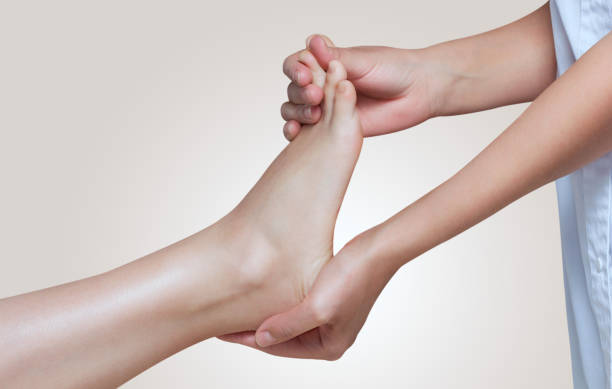Have you ever returned home from a visit to the doctor with more questions than answers? It is important to keep a list of your symptoms and any questions you may have so that you get the most out of your appointment.
Pain, numbness or swelling in your feet and ankles for no apparent reason are signs why you should regularly see your podiatrist. Here are 6 indications you should do just that.

Bunions
A bunion is a painful bump that forms at the base of the big toe. It develops when the bones that form the big toe joint change shape, pushing the toe at an angle towards the second toe. It causes pressure against the skin and irritates it, leading to calluses and corns. It can also lead to pain in the ball of the foot, called metatarsalgia. The bump is usually surrounded by bursae (painful fluid-filled sacs that cushion the feet).
A podiatrist will diagnose bunions through a physical examination. They’ll look at the bump, check how your toes move when you stand, walk and sit, and ask about your symptoms. They’ll also x-ray your foot.
Podiatrists have training in foot biomechanics and know how to maintain healthy feet and treat bunions using a range of treatments. These include splints and orthotics (special shoe inserts shaped to your feet) that reposition the big toe, and reduce the amount of pressure on the area. They can also prescribe medicines to reduce pain and swelling. If these don’t help, surgery may be recommended.
Calluses and corns
Corns and calluses are hard areas of thick skin that develop when the body tries to protect an area from pressure or friction. They are more common on the bottom of your feet — on the bony areas that carry most of your weight, on the big toes or heels — but they can also form on the hands of people who use them for repetitive activities such as guitar players or weightlifters.
Both can be painful and cause you to walk differently or have difficulty wearing shoes. You may be able to manage them at home with routine soaking and filing with a pumice stone or foot file, moisturizing the area and using donut-shaped shoe inserts, which can relieve pressure.
If you can’t manage them at home or they interfere with daily activities, see a local podiatrists. They will ask you questions about your symptoms, watch you walk and perform a physical exam of your feet. X-rays of your feet may be done, especially if the doctor suspects an underlying issue such as a deformity or arthritis.

Lumps
Despite the fact that most bumps and lumps on the feet and ankles aren’t dangerous, it is still important to see a podiatrist if you notice them growing larger. In addition, it is essential to consult with a podiatrist if the foot bump is painful or interferes with your daily activities.
For example, a pain-causing lump can be a plantar fibroma, a noncancerous, firm nodule of fibrous tissue that develops on the bottom of the foot’s arch. It is also possible that the bump may be a ganglion cyst, which is a sac filled with jellylike fluid that grows in a tendon sheath or joint capsule and often forms on the heel.
A podiatrist can help treat many common conditions of the feet and ankles, such as bunions, hammertoes, and calluses and corns. In addition, they can diagnose and treat more serious conditions, such as sprains, fractures, and arthritis. They can also advise on footwear and other lifestyle adjustments to prevent foot injuries and speed recovery from those that do occur. They can perform tests, such as an ankle-brachial pressure index test, that can help identify circulation problems in the lower legs and feet.
Fungal infections
Fungi (mushrooms, mildew and mold) are primitive organisms that grow in moist, warm, unwashed areas like the area of your feet and toenails. They spread via tiny spores in the air that you can inhale or they can land on you in public places like showers and locker rooms. Fungal infections can be cured by following basic preventive measures such as washing your feet daily with soap and water, allowing them to dry thoroughly, avoiding shoes made of materials that don’t breathe, and cutting your toenails straight across.
Fungus infections of the nails can be difficult to treat at home. If you notice your nails are brittle, discolored or thickened and/or they separate from the nail bed and emit a foul odor, make an appointment with a podiatrist to discuss treatment options.
Swelling in your foot is another indication to see a podiatrist. This can indicate an injury or an infection, poor circulation and even serious conditions such as diabetes or nerve damage. Failing to get the condition treated could lead to permanent damage.
Pain
If you have pain in your feet or ankles that doesn’t go away, it may be time to visit a podiatrist. Podiatrists can help you with many foot and ankle issues such as bunions, calluses, ingrown toenails, heel spurs and shortened tendons. They can also treat sports injuries, such as sprains and strains.
Symptoms of a sprain or strain include swelling, pain and a noticeable difference in the injured area. Seeing a podiatrist right away will ensure that the injury is properly treated, so you can return to your normal activities sooner.
Neuromas are painful conditions that occur when a nerve becomes compressed and thickened, often due to narrow, high-heeled shoes. A podiatrist can assess the condition and develop a treatment plan that may involve medication, orthotics or surgery. They can also help you with nutritional advice, proper foot hygienic practices and which footwear is best for you.
